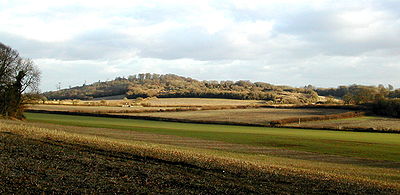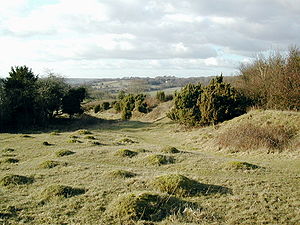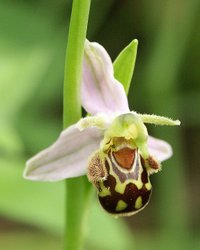
Noar Hill
Encyclopedia

Selborne
Selborne is a village in the East Hampshire district of Hampshire, England. It is south of Alton. It will be just within the extreme northern boundary of the proposed South Downs National Park, which is due to take effect in mid-2010....
in East Hampshire
East Hampshire
East Hampshire is a local government district in Hampshire, England. Its council is based in Petersfield. Other towns are Alton, Horndean and Whitehill-Bordon....
, is best known for its nature reserve
Nature reserve
A nature reserve is a protected area of importance for wildlife, flora, fauna or features of geological or other special interest, which is reserved and managed for conservation and to provide special opportunities for study or research...
.
Etymology
Nore is an obsolete spelling of nor, north. Noar is a variant of nore.Topography and management
The hill is at 51°04′30"N 0°56′00"W (Ordnance Survey reference ) and lies in the parish of Newton ValenceNewton Valence
Newton Valence is a village and civil parish in the East Hampshire district of Hampshire, England. It is 4.4 miles south of Alton, just off the A32 road....
, in the East Hampshire Area of Outstanding Natural Beauty
Area of Outstanding Natural Beauty
An Area of Outstanding Natural Beauty is an area of countryside considered to have significant landscape value in England, Wales or Northern Ireland, that has been specially designated by the Countryside Agency on behalf of the United Kingdom government; the Countryside Council for Wales on...
..
It forms one of the westerly outposts of the chalk
Chalk
Chalk is a soft, white, porous sedimentary rock, a form of limestone composed of the mineral calcite. Calcite is calcium carbonate or CaCO3. It forms under reasonably deep marine conditions from the gradual accumulation of minute calcite plates shed from micro-organisms called coccolithophores....
hills called the South Downs
South Downs
The South Downs is a range of chalk hills that extends for about across the south-eastern coastal counties of England from the Itchen Valley of Hampshire in the west to Beachy Head, near Eastbourne, East Sussex, in the east. It is bounded on its northern side by a steep escarpment, from whose...
, and rises to a maximum height of about 210 metres above sea-level. The western and northern flanks slope fairly gently, but the eastern and southern flanks in places reach a gradient exceeding 60%.
Gilbert White
Gilbert White
Gilbert White FRS was a pioneering English naturalist and ornithologist.-Life:White was born in his grandfather's vicarage at Selborne in Hampshire. He was educated at the Holy Ghost School and by a private tutor in Basingstoke before going to Oriel College, Oxford...
, in his Natural History of Selborne, http://www.gutenberg.org/etext/1408 says of Noar Hill:
"At each end of the village [Selborne], which runs from south-east to north-west, arises a small rivulet: that at the north-west end frequently fails: but the other is a fine perennial spring little influenced by drought or wet seasons, calledWell-head. This breaks out of some high grounds adjoining to Nore Hill, a noble chalk promontory, remarkable for sending forth two streams into two different seas. The one to the south becomes a branch of the Arun, running to Arundel, and so falling into the British channel: the other to the north."
(Letter I to Thomas Pennant.)

Arable land
In geography and agriculture, arable land is land that can be used for growing crops. It includes all land under temporary crops , temporary meadows for mowing or pasture, land under market and kitchen gardens and land temporarily fallow...
fields. A smaller part of the summit, 20 hectares (about 49 acres) known as High Common, is covered with downland grasses and scrub. The northern, eastern and southern flanks are covered by deciduous woodland dominated by beech
European Beech
Fagus sylvatica, the European Beech or Common Beech, is a deciduous tree belonging to the beech family Fagaceae.-Natural range:...
. Such beechwoods on steep hills in East Hampshire are termed "hangers".
High Common is the site of mediaeval chalk-workings – chalk was dug out and spread on nearby fields as fertilizer
Fertilizer
Fertilizer is any organic or inorganic material of natural or synthetic origin that is added to a soil to supply one or more plant nutrients essential to the growth of plants. A recent assessment found that about 40 to 60% of crop yields are attributable to commercial fertilizer use...
. The excavations have left an irregular network of pits and hollows of varying size, depth, and steepness. Because the ground is so uneven, High Common remained unploughed for centuries and was only used for grazing. It retains the ancient chalk downland flora which elsewhere has largely been lost.
Its importance was officially recognized in 1982, when it was declared a nature reserve
Nature reserve
A nature reserve is a protected area of importance for wildlife, flora, fauna or features of geological or other special interest, which is reserved and managed for conservation and to provide special opportunities for study or research...
. It also has SSSI status. The reserve is managed by the Hampshire and Isle of Wight Wildlife Trust
Hampshire and Isle of Wight Wildlife Trust
The Hampshire and Isle of Wight Wildlife Trust is a wildlife trust covering the counties of Hampshire and the Isle of Wight, England.They are the leading local wildlife conservation charity in Hampshire and the Island...
. When first declared, about two-thirds of the reserve were covered by scrub, a great deal of which has now been removed, though management today still requires constant scrub-control and regular coppicing of hazel
Common Hazel
Corylus avellana, the Common Hazel, is a species of hazel native to Europe and western Asia, from the British Isles south to Iberia, Greece, Turkey and Cyprus, north to central Scandinavia, and east to the central Ural Mountains, the Caucasus, and northwestern Iran. It is an important component of...
. Grazing is used to maintain the close-cropped turf on which many of the other plants and insects depend.
Flora
The chalk-diggings not only made High Common unsuitable for ploughing, but also left bare chalk exposed. The many inclines and aspects of the disused pits provide different microclimateMicroclimate
A microclimate is a local atmospheric zone where the climate differs from the surrounding area. The term may refer to areas as small as a few square feet or as large as many square miles...
s, all of which add to the variety of the flora.
Noar Hill is noted for its calcicole
Calcicole
A calcicole or calciphyte is a plant that does not tolerate acidic soil. The word is derived from the Latin 'to dwell on chalk'. Under acidic conditions, aluminium becomes more soluble and phosphate-less. As a consequence, calcicoles grown on acidic soils often develop the symptoms of aluminium...
s (chalk-dwelling plants). These include Hairy Rock-cress
Arabis
Arabis , or rockcress, is a genus of flowering plants, within the family Brassicaceae, subfamily Brassicoideae.Though traditionally recognized as a large genus with many Old World and New World members, more recent evaluations of the relationships among these species using genetic data suggest that...
Arabis hirsuta, Dropwort
Dropwort
Dropwort , also known as Fern-leaf Dropwort, is a perennial herb of the family Rosaceae closely related to Meadowsweet...
Filipendula vulgaris, Harsh Downy-rose
Rose
A rose is a woody perennial of the genus Rosa, within the family Rosaceae. There are over 100 species. They form a group of erect shrubs, and climbing or trailing plants, with stems that are often armed with sharp prickles. Flowers are large and showy, in colours ranging from white through yellows...
Rosa tomentosa, Pale Flax
Flax
Flax is a member of the genus Linum in the family Linaceae. It is native to the region extending from the eastern Mediterranean to India and was probably first domesticated in the Fertile Crescent...
Linum bienne, Common Milkwort
Polygala
Polygala is a genus of about 500 species of flowering plants belonging to the family Polygalaceae, commonly known as milkwort or snakeroot...
Polygala vulgaris, Marjoram
Oregano
Oregano – scientifically named Origanum vulgare by Carolus Linnaeus – is a common species of Origanum, a genus of the mint family . It is native to warm-temperate western and southwestern Eurasia and the Mediterranean region.Oregano is a perennial herb, growing from 20–80 cm tall,...
Origanum vulgare, wild thyme
Thyme
Thyme is a culinary and medicinal herb of the genus Thymus.-History:Ancient Egyptians used thyme for embalming. The ancient Greeks used it in their baths and burnt it as incense in their temples, believing it was a source of courage...
(two species: Large Thyme Thymus pulegioides and Th. polytrichus), Eyebright Euphrasia nemorosa, and Clustered Bellflower
Campanula
Campanula is one of several genera in the family Campanulaceae with the common name bellflower. It takes its name from their bell-shaped flowers—campanula is Latin for "little bell"....
Campanula glomerata.
Small-leaved Sweet-briar
Rose
A rose is a woody perennial of the genus Rosa, within the family Rosaceae. There are over 100 species. They form a group of erect shrubs, and climbing or trailing plants, with stems that are often armed with sharp prickles. Flowers are large and showy, in colours ranging from white through yellows...
Rosa agrestis was recorded in 1978. Four bushes of Box
Buxus
Buxus is a genus of about 70 species in the family Buxaceae. Common names include box or boxwood ....
Buxus sempervirens growing on the landslip are considered by Dr Francis Rose
Francis Rose
Francis Rose MBE was an English field botanist and conservationist. He was an author, researcher and teacher. His ecological interests in Britain and Europe included bryophytes, fungi, higher plants, plant communities and woodlands.Rose was born in south London...
to be native. Early Gentian
Gentianaceae
Gentianaceae are a family of flowering plants of 87 genera and over 1500 species. Flowers are actinomorphic and bisexual with fused sepals and petals. The stamens are attached to the inside of the petals and alternate with the corolla lobes. There is a glandular disk at the base of the gynoecium,...
Gentianella anglica has been found (1951, 1988, 1994) on the bare chalk-scree. The parasitic Knapweed Broomrape
Broomrape
Broomrape or Broom-rape is a genus of over 200 species of parasitic herbaceous plants in the family Orobanchaceae, mostly native to the temperate Northern Hemisphere. Some species formerly included in this genus are now referred to the genus Conopholis.The broomrape plant is small, from...
Orobanche elatior is regularly recorded. Juniper
Juniperus communis
Juniperus communis, the Common Juniper, is a species in the genus Juniperus, in the family Cupressaceae. It has the largest range of any woody plant, throughout the cool temperate Northern Hemisphere from the Arctic south in mountains to around 30°N latitude in North America, Europe and Asia.-...
Juniperus communis thrives; and in spring there is a beautiful display of Cowslip
Primula veris
Primula veris is a flowering plant in the genus Primula. The species is found throughout most of temperate Europe and Asia, and although absent from more northerly areas including much of northwest Scotland, it reappears in northernmost Sutherland and Orkney.-Names:The common name cowslip derives...
Primula veris.
There are occasional findings of Dragon's-teeth Tetragonolobus maritimus and Fern-grass Catapodium rigidum.

Listera ovata)
Ophrys
The genus Ophrys is a large group of orchids from the alliance Orchis in the subtribe Orchidinae. There are many natural hybrids. The type species is Ophrys insectifera L.1753...
(Ophrys insectifera)
Ophrys
The genus Ophrys is a large group of orchids from the alliance Orchis in the subtribe Orchidinae. There are many natural hybrids. The type species is Ophrys insectifera L.1753...
(O. apifera)
The colony of musk orchids runs to approximately 10,000 spikes and is of national importance.
High Common, surrounded by botanically impoverished farmland, provides both a refuge for chalk downland species and a reservoir from which recolonization of nearby areas is possible. The habitat restoration being undertaken at Selborne Common
Selborne Common
Selborne Common comprises of woodland and relict wood-pasture to the west and south of Selborne, at , in the English county of Hampshire. It is owned and managed by the National Trust.-Topography:...
may be one beneficiary.
Fauna
Noar Hill is home to the only British species (Chirocephalus diaphanus) of the curious Fairy ShrimpFairy shrimp
Anostraca is one of the four orders of crustaceans in the class Branchiopoda; its members are also known as fairy shrimp. They are usually long . Most species have 20 body segments, bearing 11 pairs of leaf-like phyllopodia , and the body lacks a carapace...
, which lives in puddles on the tracks and survives as eggs when the mud dries. Glow-worms Lampyris
Lampyris
Lampyris is a genus of beetle in the firefly family . In most of western Eurasia, they are the predominant fireflies. They produce a continuous glow.; the larvae and larviform females are among those organisms commonly called "glowworms"....
noctiluca are occasionally seen over the reserve on summer evenings. Grasshoppers abound, including the Rufous Grasshopper
Rufous Grasshopper
The rufous grasshopper is a medium-sized, broad, brown grasshopper with clubbed antennae that are tipped with a conspicuous white or pale color. This insect is known as both Gomphocerippus rufus and Gomphocerus rufus. It is fairly large, averaging 14 to 22 mm in length. It is of the family...
Gomphocerippus rufus.
The butterflies include Marbled White Melanargia galathea, Brown Argus
Brown Argus
The Brown Argus is a butterfly in the family Lycaenidae.-Appearance, behaviour and distribution:Although one of the "Blues" both sexes are brown on the uppersides with a band of orange spots at the border of each wing...
Aricia agestis, Duke of Burgundy Hamearis lucina, Brown Hairstreak
Brown Hairstreak
The Brown Hairstreak is a butterfly in the family Lycaenidae. The range includes most of the Palaearctic.-Subspecies:...
Thecla betulae, and Holly Blue
Holly Blue
The Holly Blue , is a butterfly that belongs to the Lycaenids or Blues family and is native to Eurasia and North America.In India, it is known as the Hill Hedge Blue...
Celastrina argiolus, besides large numbers of more common species.
The reserve is a good place to look for Slow-worms Anguis fragilis. It supports breeding Turtle Doves Streptopelia turtur; and Green Woodpeckers Picus viridis, which are fond of feeding on ants, are frequent. Several pairs of Common Buzzards
Common Buzzard
The Common Buzzard is a medium to large bird of prey, whose range covers most of Europe and extends into Asia. It is usually resident all year, except in the coldest parts of its range, and in the case of one subspecies.-Description:...
Buteo buteo are resident in the area and the rabbits on High Common are a favourite prey. Hen Harrier
Hen Harrier
The Hen Harrier or Northern Harrier is a bird of prey. It breeds throughout the northern parts of the northern hemisphere in Canada and the northernmost USA, and in northern Eurasia. This species is polytypic, with two subspecies. Marsh Hawk is a historical name for the American form.It migrates...
Circus cyaneus is an occasional winter visitor. For some reason – perhaps the abundance of rosehips – Bullfinches
Eurasian Bullfinch
The Bullfinch, Common Bullfinch or Eurasian Bullfinch is a small passerine bird in the finch family Fringillidae. In Anglophone Europe it is known simply as Bullfinch, as it is the original bird to bear the name bullfinch.This bird breeds across Europe and temperate Asia...
Pyrrhula pyrrhula are always to be found upon the hill.

